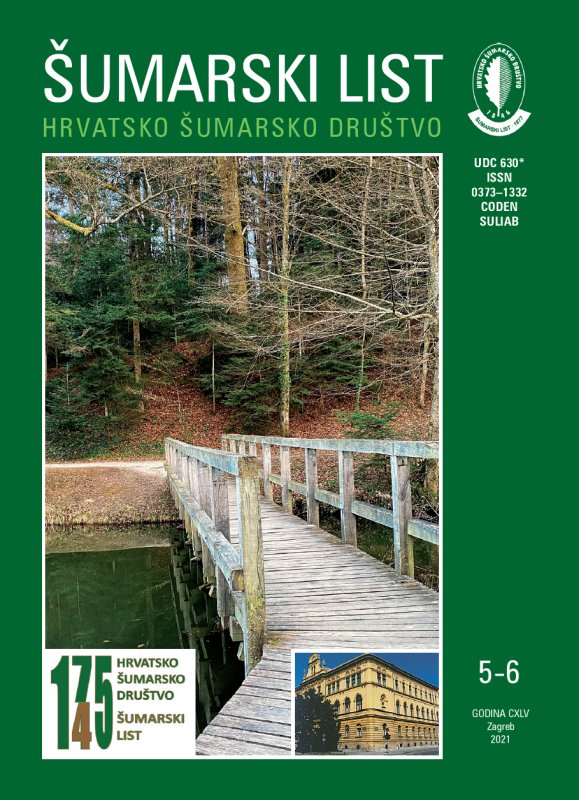
broj: 5-6/2021
pdf (15,7 MB) |
|
||||||||||||||
| RIJEČ UREDNIŠTVA | ||
| Uredništvo | ||
| The demise of a man who has devoted his life to forests and forestry pdf HR EN | 209 | |
| IZVORNI ZNANSTVENI ČLANCI | ||
| Tomislav Poršinsky, Vitomir Kajgana, Željko Tomašić, Andreja Đuka | UDK 630* 453 (001) https://doi.org/10.31298/sl.145.5-6.1 | |
| Gradeability of the cable skidder based on traction performance pdf HR EN | 211 | |
| Krunoslav Sever, Dimitrije Damir Sviličić, Tomislav Karažija, Boris Lazarević, Željko Škvorc | UDK 630*232.3 (001) https://doi.org/10.31298/sl.145.5-6.2 | |
| Photosynthetic response of common beech seedlings to suboptimal mineral nutrition pdf HR EN | 225 | |
| Ahmet Lojo, Jusuf Musić, Besim Balić, Admir Avdagić, Velid Halilović, Aida Ibrahimspahić, Jelena Knežević | UDK 630* 523 (001) https://doi.org/10.31298/sl.145.5-6.3 | |
| Modeling bark thickness of beech (Fagus sylvatica L.) pdf HR EN | 239 | |
| Tark Çtgez, Refik Karagül, Mehmet Özcan | UDK 630*114.1 + 116 https://doi.org/10.31298/sl.145.5-6.4 | |
| Evaluation of the effects of some watershed characteristics on water and suspended sediment yield in agricultural and forest dominated watersheds pdf HR EN | 249 | |
| PRETHODNO PRIOPĆENJE | ||
| Nediljko Landeka, Mirela Uzelac, Danijela Poljuha, Barbara Sladonja | UDK 630* 453 https://doi.org/10.31298/sl.145.5-6.5 | |
| The first record of the asiatic string cottony scale Takahashia japonica in Croatia pdf HR EN | 263 | |
| Toni Safner, Ana Gracanin, Ivan Gligora, Boštjan Pokorny, Katarina Flajšman, Marco Apollonio, Nikica Šprem | UDK 630* 461 https://doi.org/10.31298/sl.145.5-6.6 | |
| State border fences as a threat to habitat connectivity: a case study from South-Eastern Europe pdf HR EN | 269 | |
| Summary The conservation value of transboundary management of wildlife populations in Europe, that marked end of the 20th and the beginning of the 21th century, has come under huge pressure since 2015 especially in the South-eastern Europe due to border fences construction in response to large influxes of refugees/migrants. The primary aim of this study was to present data on the direct impacts of the long fence on wildlife (e.g. fence-related mortality) across the Hungary–Croatia border. We collected data on fence-related animal mortality along 136 km of the fence in the first 28 months after its construction. In total, 64 ungulates (38 red deer, 23 roe deer, and three wild boar) were found entangled in or deceased due to the razor wire fence. In addition, we present direct (photographic) evidence of newly recorded behaviour of red deer, as they gather in huge herds attempting to cross the border fence between Hungary and Croatia. Short term effect of the border fence is reflected in direct animal mortality, and as obstruction to the movement and behaviour of animals. In the case that current fences will remain or continue to expand along the northern boundary of South-eastern Europe, it is likely that fragmented wildlife populations in the region will suffer from negative effects of genetic subdivision such as loss of alleles and reduced heterozygosity that can cause important long-term damage to their vitality. Key words: Border fence; Wild ungulate mortality; Habitat fragmentation; Red deer; Roe deer; Wild boar; South-eastern Europe | ||
| PREGLEDNI ČLANCI | ||
| Marina Milović, Marko Kebert, Saša Orlović | UDK 630* 172.8 https://doi.org/10.31298/sl.145.5-6.7 | |
| How mycorrhizas can help forests to cope with ongoing climate change? pdf HR EN | 279 | |


